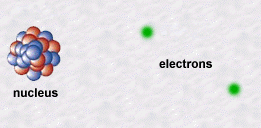or
Little atom history
![]() THE
FOUR ELEMENTS OF EMPEDOCLE OF AGRIGENTE
THE
FOUR ELEMENTS OF EMPEDOCLE OF AGRIGENTE
From his beautiful Sicilien villa in Agrigente, the Greek Empedocle
(around 492-432 BC.) divided matter into four elements, that he
also called "roots":
|
|
earth | air |
|
These elements are walled in by the forces of love and hate.
With absolute love, they form an homogenous unity, whereas hate separates
them. While these two continue to enter into conflict, the mixing of elements
gives rise to all material things.
This vision of matter in some ways pre-empted our own, with the notion
of elements bound by forces of attraction and repulsion.
![]()
![]() THE
GREEK ATOMISTS
THE
GREEK ATOMISTS

The word "atom" comes from the greek "a-tomos" and signifies "indivisible".
This notion was invented by Leucippe of Milet in 420 before J.C.
![]() His disciple, Democrite
of Abdere (around 460-370 BC.), explained that matter was made up of
particles in perpetual motion and endowed with ideal qualities:
His disciple, Democrite
of Abdere (around 460-370 BC.), explained that matter was made up of
particles in perpetual motion and endowed with ideal qualities:
invisible because of their extremely small size indivisible as their name indicates solid (no void inside) eternal because they are perfect surrounded by an empty space (to explain their movement and changes in density) having an infinite number of shapes (to explain the diversity observed in nature)
| The atom is it Greek in origin?
|
The Greek atomist doctrine lay forgotten in the dark throughout the
long centuries and left in its place a durable triumph of the theory of
four elements of Empédocle.
![]()
![]() THE
ALCHEMY OF THE MIDDLE AGES
THE
ALCHEMY OF THE MIDDLE AGES
Originating in the Middle Ages, alchemy was born from the progress of metalurgy and from the inadequacy of the theory of the 4 elements for representing the diversity of matter.
 The "grand
plan" of alchemy was to achieve the transmutation of lowly metals
(like copper) into "noble" metals such as gold. Without doubt because the
success of such "Grand Works" (transmutation) opened up prospects
of wealth and power, the activities of alchemists were surrounded by secrecy
and were performed using extremely ancient processes of the esoteric and
of the occult.
The "grand
plan" of alchemy was to achieve the transmutation of lowly metals
(like copper) into "noble" metals such as gold. Without doubt because the
success of such "Grand Works" (transmutation) opened up prospects
of wealth and power, the activities of alchemists were surrounded by secrecy
and were performed using extremely ancient processes of the esoteric and
of the occult.
The beginnings of alchemy (like those of astrology for that matter)
established symbolic links which united the microcosme and macrocosme (the
world of planets). For example, the element Lead was associated with the
planet Saturn because Saturn appears to us have a "leaded" yellow colour.
Inspite of their esoteric beliefs, alchemists developed the observation,
experimentation, measurement and classification of the elements: alchemy
is therefore a respectable precursor of chemistry. Anyway, don't forget
that Newton was adept at alchemy and that todays physics has turned the
old dream of transmutation into reality by transforming certain atoms into
other atoms.
![]()
 In
1869, the russian chemist Dimitri Mendeleïev constructed a
table which classified all of the chemical elements known at that time
according to their chemical properties. This table later served to methodically
classify all of the atoms, both natural and man made, by their atomic
number (that is to say the number of protons that they contain).
In
1869, the russian chemist Dimitri Mendeleïev constructed a
table which classified all of the chemical elements known at that time
according to their chemical properties. This table later served to methodically
classify all of the atoms, both natural and man made, by their atomic
number (that is to say the number of protons that they contain).
![]()
![]() DISCOVERY
OF THE ELECTRON
DISCOVERY
OF THE ELECTRON
Then
in 1897,
Thompson discovered the first component part of the atom:
the
electron, a particle with a negative electric charge.
In 1904, he proposed an initial model of an atom, since nicknamed "Thompsons
pudding".
He imagined the atom as a sphere full of an electrically positive substance
mixed with negative electron "like the raisins in a cake".
![]()
![]() DISCOVERY
OF THE NUCLEUS
DISCOVERY
OF THE NUCLEUS
In
1912, Rutherford (New Zealand physicist) discovered the atomic
nucleus.
His new model of the atom showed that its positive electric charge
and the majority of its mass were concentrated in an almost point sized
nucleus.
The electron in an atom moves around this nucleus like planets around
the Sun, and the attractive electric force (the - charge of the electron
attracting the + charge of the nucleus) plays the role which gravity plays
for the planets; which is where we get the name "atomic planetary model".
It is worth noting that in contrast to the atom of the Greeks, Rutherfords
is neither indivisible (because it's a composite structure), nor is it
solid as it contains mostly empty space: The distance nucleus-electrons
is 100,000 times greater than the diameter of the nucleus itself (diameter
of the nucleus = 10-15 metres = 1 Fermi).
![]()
![]() DISCOVERY
OF NUCLEONS
DISCOVERY
OF NUCLEONS
Rutherford understood that the nucleus is itself composed of nucleons. These nucleons are of two types:
The planetary model of the atom has a serious deficiency. The electrons
can emit light under certain conditions (in an electric light bulb for
example); in doing so, they lose energy and should therefore get dangerously
close to the nucleus right up until they crash into it!
Such an atom would not therefore be stable.
![]()
![]() BOHRS
ATOM
BOHRS
ATOM
In order to take account of atomic stability, in 1913 Niels Bohr
created a new model of the atom:
The orbits of the electrons can't be just anywhere but are "quantified";
only certain particular orbits are permitted for the electron. It's not
until one jumps from one orbit to another that it can emit (or absorb)
light.

![]()
![]() TOWARDS
QUANTUM PHYSICS
TOWARDS
QUANTUM PHYSICS
Bohr's model is the last model obedient to classical physics,
that is to say physics which explains movements and phenomena in terms
of our human scale. These models of atoms are therefore easy to understand
and to represent.
What an intellectual pleasure (and what laziness!) to represent atoms
in the form of little balls turning one around another...
This model is moreover, still the one which the general public have
in their heads.
In fact this model is false because at the atomic scale, new laws apply!
These laws are part of a strange physics, very far from our current concepts:
quantum
physics.
![]()
![]() Before continuing our
descent towards the constituants of the nucleus and discovering what quantum
physics is and its consequence on the representation of the atom, let's
ljust look at what physicists knew about the atom in the 1930s:
Before continuing our
descent towards the constituants of the nucleus and discovering what quantum
physics is and its consequence on the representation of the atom, let's
ljust look at what physicists knew about the atom in the 1930s:
For the lazy and as a world exclusive: the crazyflash,
a quick summary of the web page:
|
|
|